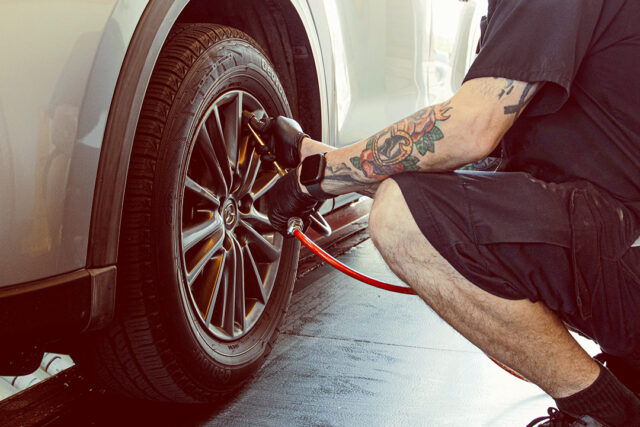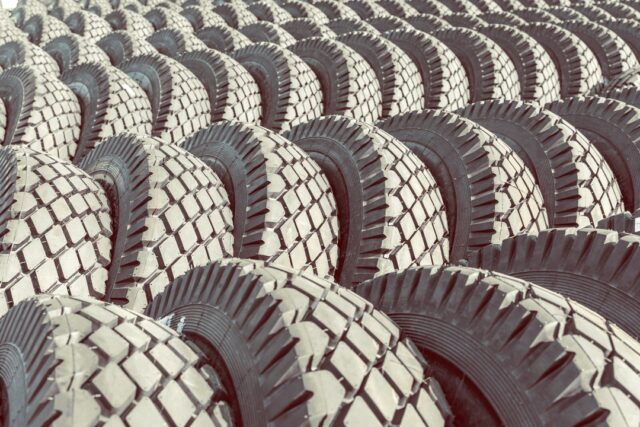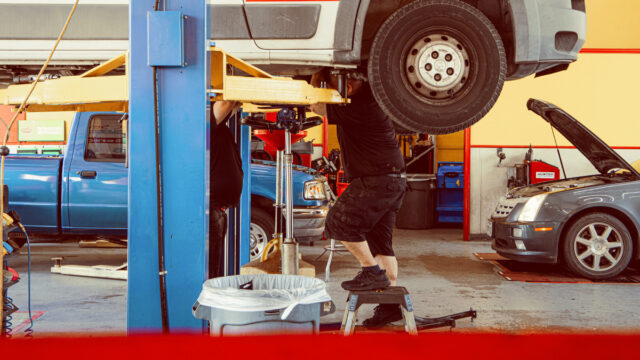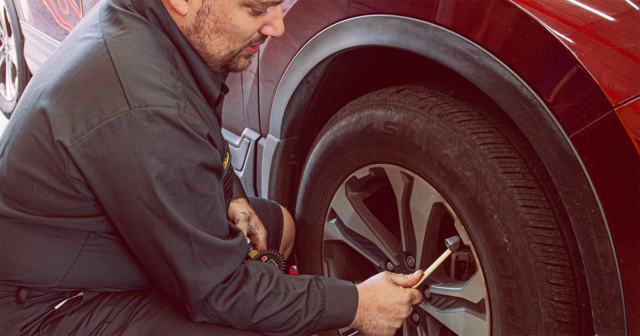Did you know that your tires can stiffen up in freezing temperatures, making it harder for them to grip the road? Or that scorching summer heat can cause your tires to wear down faster, especially on hot pavement?
If you’ve ever noticed your car feeling a little off after the first cold snap or your tires looking more worn after a summer road trip, there’s a reason for it. Temperature shifts, moisture levels, and road conditions all play a role in tire performance, and understanding these seasonal effects can help you avoid unexpected issues. In this blog, we’ll break down what happens to your tires as the weather changes and what you can do to keep them in the best shape all year long.
How Winter Wreaks Havoc on Tire Performance
Winter might not bring feet of snow to Texas often, but that doesn’t mean your tires get off easy. Even a mild winter can create problems that impact tire performance, safety, and longevity.
Why Winter is Tough on Your Tires
- Cold air reduces tire pressure – For every 10-degree drop in temperature, tire pressure can decrease by about 1-2 PSI. Underinflated tires wear unevenly, reduce fuel efficiency, and struggle to maintain grip, especially on icy or wet roads.
- Rubber stiffens in colder temps – Tires are made of a rubber compound designed to be flexible, but when the temperature drops, the rubber hardens. This can reduce the tire’s ability to grip the road, leading to longer braking distances and poor handling.
- Hidden ice patches – Even if the roads look clear, early morning and late-night temperature dips can create black ice, particularly on bridges, overpasses, and shaded roads. Worn tires with shallow tread struggle the most in these conditions.
- Potholes and road damage – Cold weather, moisture, and fluctuating temperatures cause roads to crack and develop potholes. Hitting one at high speed can throw off your wheel alignment, damage your suspension, or even cause a blowout if your tires are already worn.
Winter Tire Maintenance Checklist:
| Task | Why It Matters |
| Check your tire pressure weekly | Cold weather naturally causes pressure loss, leading to poor traction and uneven wear. |
| Inspect your tread depth | Worn tread struggles to grip icy or wet roads. Replace if below 4/32” tread depth. |
| Rotate your tires | Ensures even wear and helps maintain grip through changing conditions. |
| Look for cracks or bulges | Cold can make rubber brittle—cracks or bulges signal a need for replacement. |
| Wash off road salt and grime | Prevents corrosion on wheels and undercarriage from de-icing treatments and winter debris. |
Prevents corrosion on wheels and undercarriage from de-icing treatments and winter debris.
Why Spring is the Season for Tire Recovery
Spring isn’t just about warmer weather, it’s also about undoing any wear and tear your tires took during winter and preparing for rising temperatures.
Getting Your Tires Ready for Spring Roads
- Winter wear lingers – Cold weather, potholes, and moisture can weaken your tires, leading to hidden damage that isn’t obvious at first glance. A spring checkup ensures any cracks, bulges, or uneven wear are caught early.
- Increased rain and wet roads – Spring showers mean slick roads. Tires with low tread struggle to maintain traction on wet pavement, increasing the risk of hydroplaning.
- Temperature swings impact inflation – As temperatures rise, tire pressure fluctuates. A tire that was underinflated in winter may now be overinflated, affecting handling and tread wear.
Spring Tire Maintenance Checklist:
| Task | Why It Matters |
| Inspect for winter damage | Check for cracks, sidewall bulges, or unusual wear caused by cold weather and potholes. |
| Test tread depth | Check your tire tread to determine if your tires have enough tread to maintain grip and prevent hydroplaning in slippery conditions. |
| Adjust tire pressure | Warmer weather can cause overinflation. Be sure to check and adjust tire pressure accordingly. |
| Rotate and balance tires | Helps extend tire life by ensuring even wear across all four wheels. |
Spring is also a great time to consider switching to summer or performance tires if you use seasonal sets.
Beating the Heat and Preventing Blowouts
Scorching pavement, high speeds, and long road trips all put extra stress on your tires, increasing the risk of wear and tear, overheating, and blowouts.
Summer Road Hazards That Can Wear Down Your Tires Faster
- Extreme heat increases tire pressure – Just like cold weather lowers pressure, hot temperatures do the opposite. Overinflated tires can lead to uneven tread wear and a higher chance of blowouts.
- Hot pavement accelerates wear – Roads in Texas can reach well over 140°F in peak summer months, causing tires to soften and wear down faster than usual.
- Heavy loads add extra strain – Summer means road trips, trailers, and extra cargo. Hauling additional weight puts pressure on your tires, increasing stress on sidewalls and making blowouts more likely.
Summer Tire Maintenance Checklist:
| Task | Why It Matters |
| Check tire pressure frequently | Heat causes air expansion—overinflated tires are more prone to blowouts. |
| Inspect for excessive wear | Hot pavement wears down tread faster—replace tires if tread depth is low. |
| Monitor sidewalls for bulges | Heat and high speeds can weaken tires, leading to dangerous sidewall damage. |
| Rotate tires before long trips | Prevents uneven wear and ensures a smoother, safer drive. |
| Avoid overloading your vehicle | Extra weight puts excess strain on tires, increasing the risk of overheating and failure. |
If you plan on heavy summer driving, consider using summer or performance tires designed to handle high temperatures better than all-season options. Also, avoid driving on underinflated or bald tires, hot weather will only make any existing issues worse.
Preparing for Shifting Temperatures and Unpredictable Roads
As the heat of summer fades, your tires go through another round of adjustments. Fall may not bring extreme conditions like winter or summer, but it’s a season of transition, which means unpredictable road hazards and maintenance concerns that are easy to overlook.
Why Fall Tire Maintenance Matters:
- Cold Mornings, Warm Afternoons = Pressure Fluctuations – Fall temperatures swing throughout the day. A crisp morning might drop your tire pressure, while a warm afternoon increases it. These constant fluctuations lead to underinflation, which reduces tire traction and fuel efficiency.
- Hidden Road Debris from Summer Construction – Fall is when road construction finally wraps up in many areas, but that means leftover gravel, loose asphalt, and potholes can pose a real threat to your tires. If you’ve been driving over rough roads all summer, now is the time to check for damage.
- Wet Leaves Mimic Icy Roads – Piles of fallen leaves might not seem like a big deal, but when they get wet, they create a slick layer that reduces traction, similar to ice. Tires with low tread depth will have a harder time gripping the road.
Fall Tire Maintenance Checklist:
| Task | Why It Matters |
| Check tire pressure weekly | Prevents handling issues caused by daily temperature swings. |
| Inspect tread depth | Ensures proper traction for wet roads and leaf-covered pavement. |
| Look for punctures or sidewall damage | Gravel and road debris from summer construction can cause slow leaks or weak spots. |
| Rotate and balance tires | Prevents uneven wear and extends tire life before winter conditions arrive. |
| Clean off leaf debris from tires and wheel wells | Wet leaves can trap moisture, leading to rubber breakdown and corrosion on wheels. |
Fall is a great time for a final maintenance check before winter. Addressing wear and tear now will help your tires be ready for whatever the colder months bring even in Texas’ unpredictable weather.
Keeping Your Tires Ready for Every Season
Every season brings its own set of challenges, temperature swings, road debris, changing traction conditions, and your tires take the hit every time you drive. The good news? A little seasonal maintenance goes a long way in preventing premature wear, blowouts, and poor handling.
Instead of waiting until something feels off, make it a habit to check in on your tires with each seasonal shift. Keep an eye on pressure as temperatures fluctuate, inspect your tread before wet or icy conditions roll in, and don’t ignore the small signs of wear. Simple steps like rotating your tires, balancing them, and making adjustments based on seasonal conditions can extend their life and improve your vehicle’s performance.




